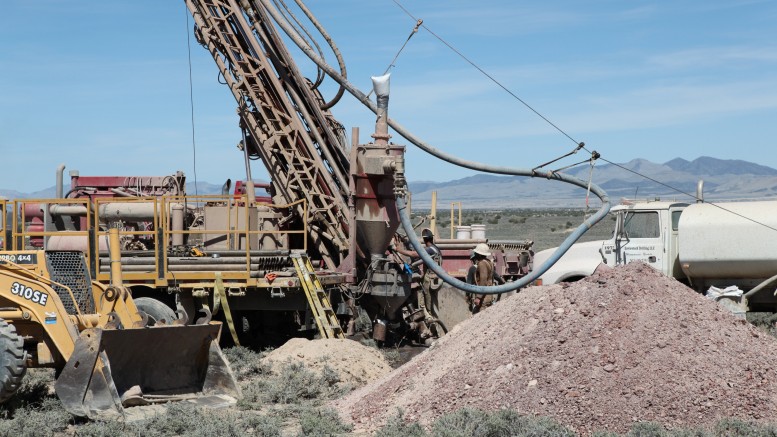This year marks Miranda Gold’s (MAD-V) most active drill season to date, with partners spending between $5 million and $7 million to test at least seven of the company’s nine joint-venture projects.
The project-generating company describes its joint projects as “lottery tickets,” and says the chance of winning the prize will increase as it generates more targets and secures partners.
While the odds of hitting a target that becomes a gold mine are slim, it is not deterring the company — led by veteran geologist Kenneth Cunningham — from exploring.
“Exploration is always a long shot,” notes Miranda’s president and CEO after a recent corporate presentation in Toronto. “I’ve been doing exploration my entire life — I love it. Making a discovery is really exciting. One of the reasons we work where we’re working is because if we make a discovery, we are hoping it’ll be very big.”
The company has 16 targets in three world-class gold jurisdictions, which include Nevada, Alaska and Colombia. Thirteen of the targets are located in Nevada.
Cunningham says the company’s geologists have been involved in over 10 discoveries, including what are now Barrick Gold’s (ABX-T, ABX-N) Cortez Hills and Goldrush deposits in Nevada.
The Vancouver-based junior has five geologists in its exploration office in Elko County, Nev., and three in Medellin, Colombia.
Miranda says its joint-venture business model helps mitigate exploration risk while conserving cash and minimizing shareholder dilution. In turn, it provides investors several chances to take part in a discovery on someone else’s dime.
The company has $6.3 million cash-on-hand and a burn rate of $2.7 million a year.
While the joint-venture model varies from partner to partner, Miranda is set to retain 30% of each project.
A typical deal in Nevada, where the company has six joint ventures, will have a partner spend $4 million for the right to spend another $10 million, or produce a feasibility study, after which it will gain a 70% equity position.
“So that’s a $14-million protection before Miranda has to participate,” Cunningham says.
He’s quick to point out that not all interested partners will buy this deal. For instance, Agnico-Eagle Mines (AEM-T, AEM-N) can earn a 51% stake at Ester Dome, Miranda’s sole project in Alaska, by spending $4 million, after which it can either spend $10 million or complete a feasibility to bring its stake up to 70%.
Miranda’s partners have yet to spend $4 million.
Agnico-Eagle has budgeted $700,000 this year to drill Ester Dome, which is located in the Tintina gold belt near Fairbanks. Last year Agnico completed its first round of drilling, where four of six holes cut gold mineralization ranging between 0.3 and 0.9 gram gold per tonne.
In Nevada, Miranda has a few partners testing the economic value of potential gold systems on the company’s targets.
NuLegacy Gold (NUG-V) plans to spend over $1 million to drill nine holes — or a combined 4,700 metres — on Miranda’s Red Hill and Coal Canyon projects in Eureka County.
NuLegacy intends to put two or three holes in Red Hill to offset -historic hole 013, which cut 24 metres of 4.96 grams gold per tonne, including 14 metres of 8.06 grams gold. The hole was one of the four drilled by Barrick in 2006 at the West Pediment prospect.
Miranda believes this may be the most significant intercept outside of Barrick’s Cortez camp. The intercept is on trend and southeast to the major’s Red Hill and Goldrush projects.
Also in Nevada this year, Montezuma Mines has allocated $776,000 to drill Miranda’s Red Canyon project in Eureka County, while Ramelius Resources has completed two holes in the Big Blue project in Lander County, and aims to drill more holes at Angel Wing in Elko County.
In Colombia Miranda has teamed up with Red Eagle Mining at two projects: Pavo Real and Cajamarca. This year Red Eagle is looking to drill eight holes in Pavo Real, located in the Tolima Department.
Editor of Exploration Insights newsletter Brent Cook describes Pavo Real as “intriguing,” given it is hosted in sediments and has a broad area of alteration and surface mineralization.
Miranda says it’s close to forming a Colombian alliance to bring down costs associated with working there. For any of the projects Miranda generates in Colombia, a partner will have a first right of refusal to participate.
To be first in-line, a partner will have to handle the lion’s share of Miranda’s costs.
Miranda has 52.9 million shares outstanding, or 60.8 million fully diluted. Management holds 6% of shares, while retail and institutional investors hold 43.5% of the company.
The junior recently closed at 33.5¢ within a 52-week range of 24¢–56¢. Cunningham hopes the share price will increase as the company’s partners keep drilling, with the hope of delineating something attractive.
“We want to either discover something so big that we get taken out by a major,” he says, “or something that is economic that our partner puts into production, so that we are the passive partner.”


Be the first to comment on "Miranda looks for a winning ticket"